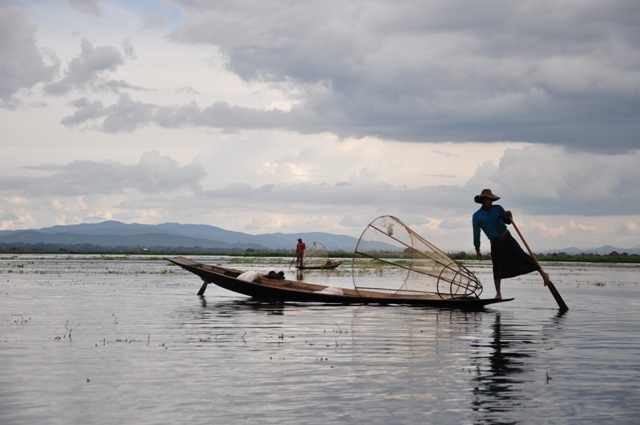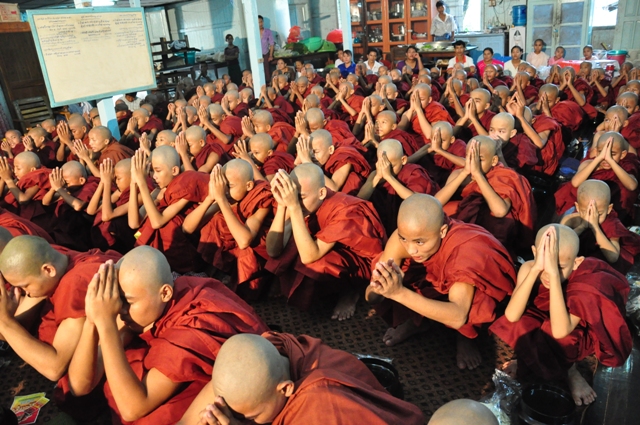The black lake
Lake Inle is a huge lake to the east of the country, where they produce most tomatoes in the floating gardens. People live in houses on water and their fishermen are known for the unique technique of paddling – with one leg. They have their arms free to use fishing nets!

With a hired boat we explored the hidden corners of the lake, saw the show with cats at the temple, visited the craft shops where they produced umbrellas, cigars and silverware. They even have hot water springs. And they really hot! I couldn’t get in the water beyond my knees. In the middle of the lake I asked out captain if I can take a swim – he said: sure! I took off my clothes and jumped in, but after a few strokes returned to the boat. The water is so dark, it’s like swimming in ink. It was very unpleasant to watch the dark depths. Next day I went to the nearby hills and local villages with my guide. The path went through thick dark woods, pass rice fields and green gardens. I spent the night at the Buddhist monastery, where I was visited by a rat during the night, which nibbled through my toilet bag and nearly got to the top of my head. The candle was long gone and there was no electricity and my flashlight spotted the rat behind the beam next to my makeshift bed. I grabbed all my things in the middle of the night and joined my guide in the next building. We all had a laugh about it the next morning. On the way back we visited some villages, schools and vineyards. Yes, that’s right – vineyards. The climate here is just right, so a German decided to raise a vineyard here to produce grapes for vine. A quick sampling costs $2, but it’s worth it, especially the late vintage.
»You’ve gave two families two days of supplies with this.«
Since I’m a real fan of Buddhist architecture I couldn’t pass by the opportunity to visit the largest monument of Myanmar. So I continued to Bago, on the way to Kinpun, from where you can easily reach the pagoda Kyaiktiyo (the Golden Rock). In Bago I again hired a motorist, who took me from temple to temple. We knew all the side entrances, so I didn’t have to pay the tickets or the general Bago pass. I asked him to take me to a school, for I was really curious to see what the classes were like. Being a retired teacher, this was no problem for him. We entered the schoolyard and were really surprised. It was full of people and music. We had the luck to be present when the new monks – it was a monk school – gave the pledge. They treated me as a celebrity: I got food and drink right away and could sit in the main hall, where even the parents didn’t have access too. I didn’t understand the pledges or prayers, but I felt their energy that filled the room. It was a one in a life time experience. Later I asked my guide about the life standard and he said that as a teacher he earned 85.000 kjat (about 85€), but now in retirement he only gets 9.500 kjat (so 9,50€). When I gave him the arranged 10.000 kjat for a day’s guidance he told me – you’ve fed two families for two days with this. With a handshake and a smile we took our farewells and I was off to find the net. In a country that doesn’t even have electricity the whole day and the mobile network is only starting to get operational and no foreign SIM card works it’s a really hard thing to do. But there’s at least one such internet café in Bano, so I could writie to the people home. While doing this somebody came up to me and patted me on the back – it was my guide. He remembered I asked him about their old currency, that lost all value after inflation so he promised he’d show it to me. He took three notes from his pockets and two coins and gave them to me – as a momentum. I was so surprised and touched I kept thanking him and asked, what to give him in return. He didn’t want anything. Happy he said goodbye and left. I felt his warm handshake for a long time and his friendliness and warmth will stay with me forever.

They journey to mount Kyaiktyo
I arrived to Kinpuna early in the morning in a heavy rainstorm. The settlement has only one street that ends in the forest where the muddy water flows down the road and makes the steps heavy. I thought I found “the end of the world.” To the mountain from the pagoda I had to go by truck. They put us on a trailer and the driver was driving uphill like crazy through many a slippery curves. We stopped at the plateau and all us, white folks, were chased of the truck. No one spoke English, so we never found out why. They just showed us the way where to go. We went further uphill for about an hour in a strong rain and came to the office, where they sell tickets ($6). They explained we had to leave the truck because the road was too dangerous for tourist. No matter, our transport never had a roof anyway, so no matter what, we were wet. Again I walked barefoot on marble, only this time it was wet. And if at the beginning of the trip I saw the Shwedagon pagoda immediately, I had to search for this one – it was surrounded by mystical fog. It’s a rock that stands on the edge of the cave against the laws of physics and on it is a small pagoda. The legends says that Buddha’s single hair holds its balance, keeping it from rolling off. A view of this miracle should be enough to make you believe and crave Buddhism. Did I? Maybe. And a desire remained to visit this country again, one way or the other. It’s a country that welcoms you warmly and rewards each effort you put into discovering it.